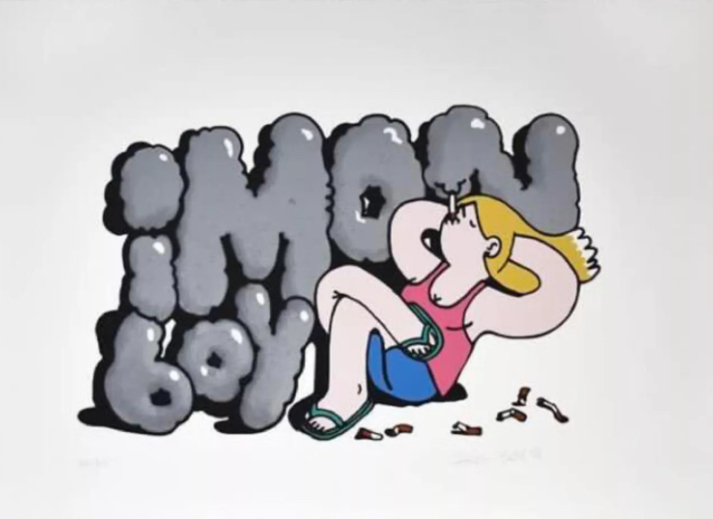Instead, he leaves you standing inside the frame, trying to fill in the gaps. I Don’t Smoke Anymore (2020) is a perfect example of that—an image that looks casual at first glance but pulls you deeper the longer you sit with it.
This 9-color screen print on Somerset Satin Rag isn’t loud. It doesn’t beg for your attention. It earns it through a kind of stripped-back storytelling: visual wit, emotional honesty, and technical sharpness wrapped into one.
And like most of Imon Boy’s work, it’s uniquely simple. Until you realize it’s about you too.
Who Is Imon Boy?
Hailing from Málaga, Spain, Imon Boy is part of the newer generation of urban artists who split their time between streets and galleries. His roots are graffiti—quick tags, coded messages, public surfaces—but his studio work takes that raw language and filters it through introspection and pop culture fluency.
Where others paint the chaos of city life, Imon Boy often paints its quieter moments: boredom, longing, daydreaming, regrets. His characters feel like avatars of adolescence, even when they deal with adult nostalgia.
His palette is candy-coated. His linework is sharp but soft. His narratives always open-ended.
With I Don’t Smoke Anymore, he locks into that signature approach, using minimal means to say something big.
About the Work:
I Don’t Smoke Anymore (2020)
The title already feels like a confession. I Don’t Smoke Anymore—present tense. Not “I quit.” Not “I used to smoke.” It’s a line spoken by someone who still thinks about it every day. Someone trying to convince themselves as much as you.
The artwork itself shows a cartoonish character, a typical Imon Boy figure, staring at a cigarette held lightly between their fingers. The figure’s eyes aren’t defiant. They’re wistful. Maybe proud, maybe sad. Probably both.
Behind them, a flat-color background isolates the subject, pulling every ounce of emotion into the details: the slouch of the shoulders, the tilt of the head, the tension between hand and cigarette.
The piece is printed on Somerset Satin Rag, a heavyweight, acid-free paper favored for its lush texture and archival stability. The 9-color screen printing process gives the image a crisp, layered vibrancy without making it feel synthetic. Each color block sits deliberately, like a pixel in a slowed-down video game memory.
It’s clean. It’s controlled. And it’s quietly devastating.
Technique: Precision in Simplicity
Nine colors might sound simple for a screen print. But in practice, it requires ruthless editing. Every shade has to justify its presence. Every overlap has to add something—weight, depth, tension.
Imon Boy’s use of flat planes of color mimics the immediacy of graffiti, but his choices are highly considered. The way the shadows fall. The decision to let certain lines stay open-ended. The slight misalignment of a color block that makes the image feel handmade, not machine-fed.
This tension between “simple” and “sophisticated” is where Imon Boy thrives. He knows that simplicity isn’t about lack. It’s about clarity. And clarity is harder than it looks.
Emotional Resonance: A Portrait of Habits
At its core, I Don’t Smoke Anymore is about the quiet violence of breaking habits. About the part of quitting no one talks about—the mourning, the ache for the rituals you used to hate.
The cigarette here isn’t just a prop. It’s a relic. A ghost. Something that defined the character, even as they try to move past it.
And Imon Boy leaves it open for you to interpret:
Is this about addiction? About self-control? About nostalgia for bad decisions?
Maybe it’s about all of it.
There’s a bittersweetness here that hits differently in a world obsessed with self-optimization and image management. It’s not glamorous. It’s not victorious. It’s honest.
Cultural Context: Smoking, Youth, and Identity
Smoking carries a different symbolism now than it did even 20 years ago. It’s no longer a rebellious default for youth. It’s a relic. A choice tinged with self-awareness.
In that context, I Don’t Smoke Anymore feels almost like an elegy—not just for smoking, but for a whole era of casual self-destruction. It captures the weird nostalgia for things we know were bad for us. For the version of ourselves that didn’t care—or pretended not to.
Imon Boy taps into that cultural shift without preaching. He doesn’t judge the act. He doesn’t romanticize it. He just shows the emotional residue it leaves behind.
Why It Matters: Vulnerability as Power
In an art world that still often rewards spectacle over substance, I Don’t Smoke Anymore is radical in its restraint.
It doesn’t try to shock. It doesn’t weaponize irony. It doesn’t bury meaning under layers of theory. It just presents a feeling—clear, exposed, unguarded.
And that’s why it sticks.
Imon Boy proves that vulnerability, rendered simply and skillfully, can be just as powerful as the loudest installation or the most controversial piece. Maybe even more.
I Don’t Smoke Anymore is small. Modest. Quiet. But it lingers.
It lingers because it’s about more than quitting smoking. It’s about the strange grief that comes with change. The tiny ways we mourn our former selves, even when we know we had to let them go.
And in that mourning, Imon Boy finds a strange, beautiful kind of peace.
You don’t need to have smoked to understand it. You just need to have lived long enough to leave something behind.
No comments yet.








